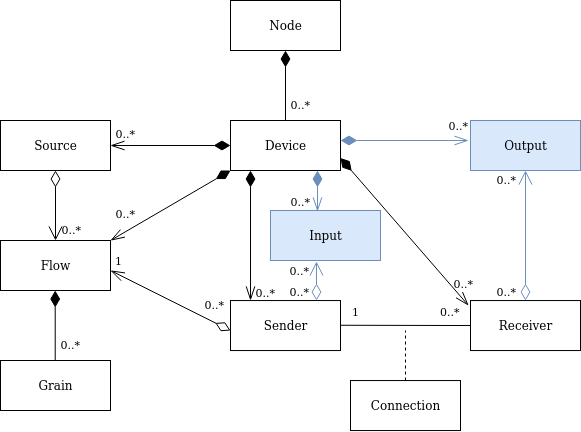Data Model: Identifier Mapping
←Interoperability · Index↑ · Behaviour→
All the language in IS-04 takes precedence.
In order to ensure consistent behaviour in a facility employing this identity, some rules apply when generating and handling identifiers.
Identity Hierarchy

The IS-04 hierarchy is preserved. Additionally, there are Input and Output resources introduced. Senders managed with IS-11 are associated with 0 or more Input resources and Receivers managed with IS-11 are associated with 0 or more Output resources.
Inputs MAY be associated with multiple Senders, e.g. an Input carrying multiple media formats at a time (e.g. video and audio) MAY be associated with multiple Senders of varying formats, an Input carrying a given media format that is segmented into multiple parts MAY be associated with multiple Senders of the same formats.
Outputs MAY be associated with multiple Receivers, e.g. an Output carrying multiple media formats at a time (e.g. video and audio) MAY be associated with multiple Receivers of varying formats, an Output carrying a given media format that is composited from multiple parts MAY be associated with multiple Receivers of the same formats.
Input Representation
A new Input is created in the following circumstance:
- At the presence of a physical interface for connection to an upstream media producing unit
Output Representation
A new Output is created in the following circumstance:
- At the presence of a physical interface for connection to a downstream media consuming unit
Identifier Persistence
As per IS-04,
Persistent identity helps to ensure that users’ expectations meet with reality. For example, if a piece of equipment is switched off and back on, the user would expect it to return with … the identifiers used by the Node remain the same.
Input ID
Owned by:
- Device ID
SHOULD change if:
- Device ID changes
- A different physical interface (such as an SDI input) is mapped to consume the signal
SHOULD NOT change if:
- A Sender is re-configured
- A different upstream counterpart is connected to the same interface
It is suggested that Input IDs be generated using the combination of:
- The parent Device ID
- A physical interface identifier such as its name, index or similar
Output ID
Owned by:
- Device ID
SHOULD change if:
- Device ID changes
- A different physical interface (such as an SDI output) is mapped to produce the signal
SHOULD NOT change if:
- A Receiver is re-configured
- A different downstream counterpart is connected to the same interface
It is suggested that Output IDs be generated using the combination of:
- The parent Device ID
- A physical interface identifier such as its name, index or similar

